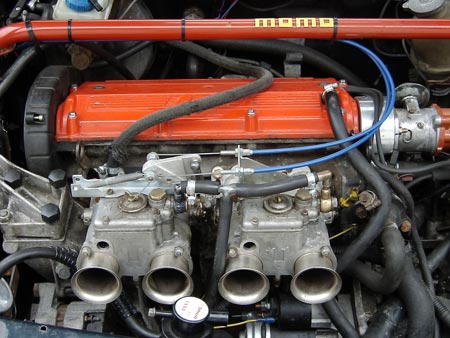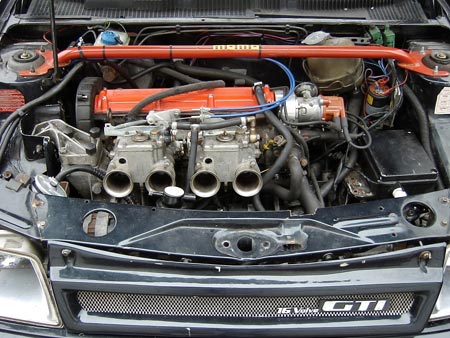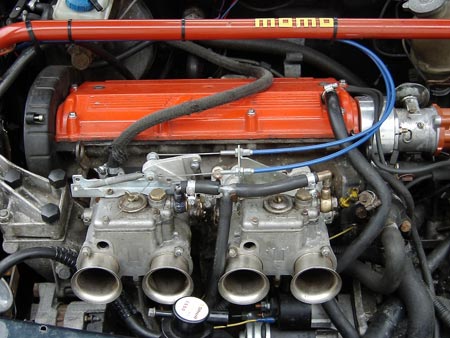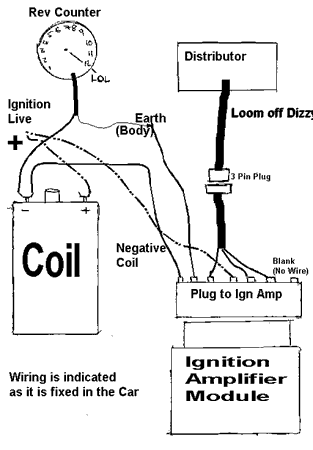
Introduction:
Converting to carbs is a great way to gain power and that great induction roar. If you thought an induction kit sounded good then you'll be amazed by the sound of some carbs roaring away! We decided to use twin Weber 45's on our 16v engine (using a 1.9 GTI distributor and Pugspares distributor adapter), but the procedure is roughly the same with any carbs and XU engines.

engine looks nice and tidy with twin carbs :-)
What parts you need:
First, a list of parts you'll need:
- Carbs - in good condition, if you got them second hand then get them serviced
- Carb manifolds and relevant gaskets
- Throttle linkage, make sure you get one that goes under the carbs because otherwise it will foul the bonnet
- Fuel pump - many people talk about getting a Facet Red Top pump for around £65 but i went for the SU pump, this was £35 from my local carb specialist and does the job perfectly
- 1.9 GTI distributor and distributor adapter from Pugspares (Mi16 only)
- 1.9 GTI coil and ignition amplifier (Mi16 only)
- Some thackory washers and bolts
- Plenty of fuel hose
- 8mm copper tube about 30 cm long
- Air filters (K&N, PiperX or some others)
- Omex rev limiter (optional but recommended)
The conversion:
First off you'll want to lose the ECU and injection loom, get hunting under the dash for all the wires and pull them out. If your unsure about any wires you can leave them there as they wont be connected. Better to be safe and leave them there than pull them out and find your car doesn't work.
Now you want to take the inlet manifold off and replace it with the carb manifolds, this should be fairly easy although some bolts are tough to get at. The carbs will be next to go on, make sure you get some rubber "O" ring gaskets for the manifold/carb joint. Put the carbs on with the gaskets and then put a thackory washer on each stud and tighten up the bolts until there about 0.5-1.0mm left between the thackory washer. Your carbs should now be sitting nicely, tidying up your engine bay. There will be a bit of flex in the carbs and this is needed so that the carb body doesn't snap when the engine is rocking back and forth.
The linkages can be next to go on, this is very simple and the method depends on which type of linkage you have purchased.
With the carbs sitting nicely on your engine its time to get some fuel to them. First you'll need to pull out the old fuel pump that is located in the tank. Take the rear seats out and pull the carpet back so you can see the 2 rubber cover plates on the fuel tank. As you are inside the car facing forwards you'll need to take the right hand plate off. You will now see about 8 nuts round the edge, take them out and pull the pump assembly out of the tank. With a bit of pulling and twisting the pump itself will come away from the top plastic section that seals the tank, this bit needs to be kept and the pump thrown away. With the old pump gone you will need to attach some 8mm copper tube to the plastic seal where the old pump attached to. There is a hole in the centre which is the old feed, push some copper pipe into that and clamp with a jubilee clip. The copper pipe needs to be long enough to reach the bottom of the tank with a bit of a bend at the end to stop it picking the sediment up off the bottom of the tank. The fuel tank can now be put back together and the interior replaced.
The SU fuel pump now needs to be fitted in the engine bay, It will fit nicely where the fuel filter sits. Remove the fuel filter and bracket and screw the fuel pump into the existing holes in the wing. Run the two wires into the dash and connect the red to a switched positive and the black to a good earth. The fuel lines from the tank run up the bulkhead with the brake lines. Figure out which is the feed i.e. the pipe coming from the copper tube you just fitted in the tank, and connect it to the inlet of the fuel pump. The outlet of the fuel pump can now go to the fuel filter inlet which can be located behind the drivers side headlight. The outlet of the fuel filter then goes to a T piece and to the inlet of each carb. When this is all connected you can test it by turning on the ignition but obviously don't try and start the car. You should hear the fuel pump clicking away filling the carb reservoir up.

a close-up pic of carbs and connections
The electrics:
The final part of converting to carbs is the ignition side. You need to mount your 1.9 GTI coil and ignition amplifier down by the expansion tank, on the right inner wing. You'll need to run a switched live to the coil positive and a very good earth to the negative. You must also remember to connect the rev counter to the coil negative. With the wiring for the ignition completed you should be finished and ready to fire up.

a quick drawing of electrics side of things, by DAZ_C
If it is an Mi16 then you'll need to fit the 1.9 GTI distributor and a distributor adapter from pugspares. This is very straightforward but as the bolt holding the rotor arm on is so tight an impact driver is a must. It is just a case of bolting the adapter onto the block then bolting the dizzy onto the adapter You must now get the timing as close as you can so that you can fire it up. You'll need to take the spark plug out of cylinder 1 (closest to the dizzy) and turn the engine over by hand until this is at the top of its stroke. Use a wooden dowel to feel the position of the cylinder and make sure it is on the compression stroke not the exhaust stroke otherwise your timing will be 180 degrees out. To check that it is on the compression stroke, pack the spark plug hole out with an old rag, it should pop out when that cylinder is compressing. Once at the very top you want to take the dizzy cap off and line the dizzy up with the point leading to spark plug number one, this takes some time as there isn't much movement in the dizzy. Remember that there are 4 bolt holes in the adaptor so you can get a wider range of movement.
The results:
With the carbs getting fuel, and the ignition system working, your engine should fire up. A few pumps of the throttle before each attempt is wise but too many will flood the engine. You should immediately notice that the engine is a lot more revvier and noisier and you'll be urged to go for a drive right away :-)! check that all (especially fuel) connections are still tight and go on a shorter blast. Remember to check it all over again when you come back home. It would be a wise thing to take your car down on a rolling road session to get the fueling and ignition spot-on and to see how big an improvement the carbs are (it would be handy if you do a RR run before the conversion as well).
Good luck and have fun!

